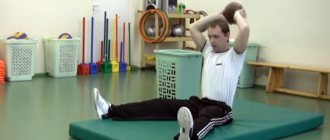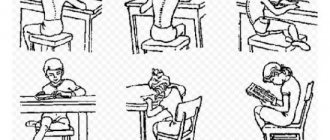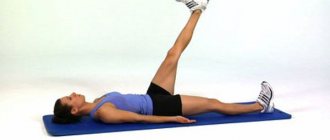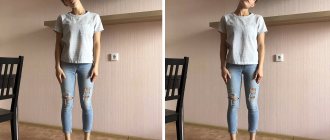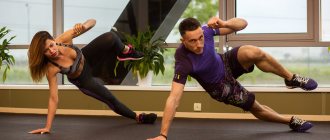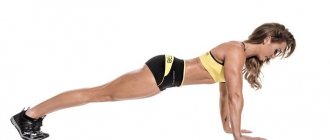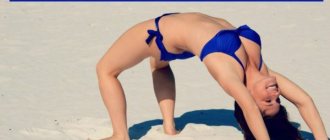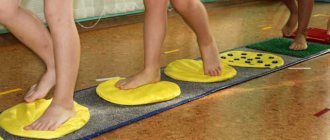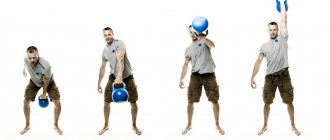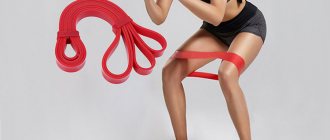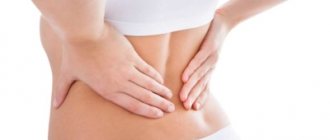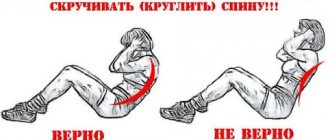BASIC EXERCISES
Outdoor exercise equipment is usually classified according to anatomical criteria, distinguishing groups of exercises with a predominant effect on different parts of the body. As evidenced by scientific data and practical experience, when compiling a complex it is necessary to be guided by the following provisions:
- The first exercises to develop are the muscles of the arms and shoulder girdle. They are usually performed at a slow pace.
- Neck exercises.
- This is followed by exercises for developing the leg muscles, alternating exercises for the leg muscles and back muscles, abdominal muscles and lateral muscles of the torso - the pelvic girdle, performed from various starting positions.
Strength exercises should precede stretching exercises.
4. The last ones in the complex are exercises that involve the main muscle groups of the whole body, performed with a large amplitude.
Finally, so-called speed exercises are used (jumping or running in place), after which the load should be gradually reduced at a slower pace. In each group, a number of exercises of a more local nature can be distinguished. For example, in the group of exercises for the arms of the shoulder girdle, there are exercises for the fingers, hands, forearms, and shoulders;
In the group for the legs and pelvic girdle - exercises for the foot, lower leg, thigh;
In the group of exercises for the torso, there are exercises for the muscles of the front or back surface of the body, etc.
The classification of exercises according to anatomical criteria is supplemented by indications of the nature of their physiological effects on the body of those involved. This refers to the predominant influence of exercises on the development of strength, speed, flexibility, and endurance.
The shape of the outdoor joint is determined by the basic movements in the joints: flexion, extension, adduction, abduction, circular movements, rotations.
The nature of the exercises largely depends on the system of muscle tension and relaxation, the speed of movements and externally manifests itself as smooth, uniform movements or movements with acceleration or deceleration, jerks, swings.
In the introductory part of the lesson, you can use specially selected games or exercises that do not require much physical stress and activate the attention of students. Based on specific conditions, the teacher must independently decide which exercises or games are most appropriate for a given lesson.
If the lesson is held in cool weather outdoors, the teacher during the introductory part should offer the most effective exercises to warm up the body. For this purpose, outdoor switchgears are carried out at a faster pace, their number increases, and therefore the duration of the entire introductory part increases. Practice has shown that to make this part of the lesson more effective and emotional, exercises with objects (jump ropes, gymnastic sticks, balls, etc.) should be used.
From a psychological point of view, the use of objects of various shapes, volumes, and masses increases the emotionality of classes, the activity and interest of children, and enriches them with new motor experience.
In connection with the above, in the examples below, exercises for various parts of the body are also grouped based on their predominant impact on the development of certain qualities.
VARIETIES OF EXERCISES
EXERCISES FOR ARM AND SHOULDER GIRT
- Exercises for fingers and hands:
a) strength exercises:
- squeezing the tennis ball on each count;
- rest on your fingertips against the wall, standing obliquely to the wall;
Also lying down:
- pushing away from the wall with your hands, resting your straight arms on the wall, standing at a distance of a step from it;
b) exercises to increase joint mobility:
- arms up, palm to palm, fingers up, lowering the arms along the body, without changing the position of the hands;
- clapping your hands in the position of elbows to the sides, fingers forward, upward;
— lying down, transferring the weight of the body from one hand to the other, changing the position of the hands: fingers forward, inward, outward.
Exercises for forearm flexors and extensors:
a) strength exercises for flexors:
- bending your arms to your shoulders with medicine balls (dumbbells), the same with a rubber shock absorber while standing on it, grabbing the ends with your hands;
- hanging pull-ups while lying down or hanging on the crossbar, rings, uneven bars;
— while lying on your arms wide apart, bending one arm. Moving the body alternately in support while lying on the left or right hand;
b) strength exercises for extensors:
— extension of the arms (push-ups) in a lying position;
- extension of the arms while lying down, from behind with hands supporting the bench, the seats of chairs;
- jumping on hands while lying down with a clap;
- extending the arms upward from a dumbbell position to the shoulders;
c) exercises to increase mobility in the shoulder joints:
- one hand is up, the other is down. Changing hand positions with a jerk at the end of the movement;
- bringing straight arms behind the back with jerks;
- from a rest position lying behind, bending your legs, springing movements. Arms straight, fingers back;
- twist the shoulder joints, moving the stick back behind the back and back, gripping the ends. The same with the rope and shock absorber.
NECK EXERCISES
a) exercises to increase joint mobility:
- tilting the head forward, backward, to the sides;
- turns the head left, right;
- circular movements of the head;
b) strength exercises:
- hands on the back of the head, tilting the head forward and back, overcoming the resistance of the hands;
- kneeling with the head resting on the palms (on a soft support), rolling from the forehead to the back of the head;
- from a lying position with bent arms (palms at the head) and legs, a wrestling bridge (on a soft support).
EXERCISES FOR THE LEG AND PELVIC GIRL
- Exercises for the foot and lower leg:
a) strength exercises:
- raising on your toes, also with dumbbells in your hands;
- walking on toes;
— jumps on two and one legs in place and with advancements;
b) exercises to increase joint mobility:
- in the forward lunge position, springing movements, trying to touch the floor with the heel located behind the leg;
- kneeling, sit on your heels. Using springy movements, lift your knees off the floor;
- walking on the outside of the foot
Exercises for thigh muscles:
a) strength exercises:
- squats on two and one legs, also with dumbbells in hands, also with a partner on the shoulders;
- walking and jumping in a half-squat;
- kneeling, bending backwards with a straight body;
- too, but forward while holding the partner’s shins.
b) exercises to increase mobility in the hip joints:
- circular movements of the pelvis while standing with your feet apart, shoulder-width apart;
- springing movements in a wide forward lunge position. The same in the position of contribution to the side;
- bending forward in a sitting position with straight legs (legs together and apart);
- half twine, twine;
- standing on one leg, swing with maximum amplitude forward, back to the side with a straight leg;
- standing on one leg, the other resting on the bar of the gymnastic wall.
Tilts towards a straight leg.
TORSO EXERCISES
- Exercises for the front surface of the body:
a) strength exercises:
— from a lying position, raising the body to a sitting position;
- lying down, raising straight legs, raising straight legs while lying on the shoulder blades, bent;
- in a lying position, arms with dumbbells to the sides. Raising dumbbells forward.
b) exercises to increase spinal mobility:
- bend back, standing with your feet apart, hands on your belt, towards your shoulders, up;
- sitting with your lower back supported on a medicine ball.
Bend back, arms up;
- push-up bridge from a lying position.
- Exercises for the back of the body:
a) strength exercises:
- bending forward with a medicine ball held by hands on the back of the head;
- lying on your stomach, bending, arms up;
- leaning forward position, raising your arms to the sides with dumbbells;
b) exercises to increase spinal mobility:
- springy forward bends;
- Exercises for the lateral surface of the body:
a) strength exercises:
- from a sitting position, legs apart, leaning on one hand, with a turn, lying on your side, the other hand up;
- in the gray-haired position, legs apart (toes catch on the rail of the gymnastic wall or while holding the partner’s legs, bend back 45 degrees and turn the body to the right, left, hands behind the head;
b) exercises to increase spinal mobility:
- springy bends of the torso to the sides in a standing position with legs apart, hands on the belt, to the shoulders, up.
EXERCISES FOR THE WHOLE BODY
- from a crouching position go to a lying position, then again crouching at a point blank position, stand up, do the same but with bending your arms in a lying position;
- walking on your hands with the help of a partner by the legs;
- in a standing position with legs apart, circular movements of the torso;
- from a standing position, sit down with your legs crossed, without using your hands, then lie down, sit down again and stand up.
EXERCISES TO FORM CORRECT POSTURE
- from a standing position against the wall with the back of your head, shoulder blades, buttocks, and heels touching it, move away from the wall, maintaining this position. Determine the difference between the usual pose and the pose of correct posture against the wall;
- holding a gymnastic stick vertically behind your back at the lower back, take a straight body position with the back of your head and spine touching the stick. Fix the pose while standing in front of the mirror;
- standing with your back to the wall, perform squats and bend your torso to the side, without lifting your back and pelvis from the wall;
- lying on your back, hands behind your head, tense your back muscles, rise to the o.s. Maintaining a straight body position with the help of partners.
Exercises for the shoulder girdle and arms
December 3, 2015
Stretching exercises
Hand circling
Rice. 1 Large circular movements with hands
Exercise 1 (Fig. 1). Starting position: basic stance - feet shoulder-width apart, arms down along the body. Large forward circles with your arms and then large backward circles with your arms. Perform for 20-30 s.
Rice. 2 Small circular movements with hands
Exercise 2 (Fig. 2). Starting position: standing, feet shoulder-width apart, arms to the sides. Small circular movements on the side of the body: first forward, then back. Perform for 20-30 s.
Rice. 3 Circular movements with straight arms
Exercise 3 (Fig. 3). Starting position: main stance. Circular movements with straight arms in front of the body: first forward, then back. Perform for 10–15 seconds in each direction.
Swing your arms
Rice. 4 Swing your arms
Exercise 1 (Fig. 4). Starting position: main stance. Swing your right hand forward-up-back, with your left hand down-back. Swing your left hand forward-up-back, with your right hand down-back. Swings are performed with maximum amplitude, with straight arms for 15–20 s.
Rice. 5 Arm swing
Exercise 2 (Fig. 5). Starting position: main stance. Rocking relaxed arms with active assistance from the torso. The right hand is forward and upward, the left hand is upward and backward, to the starting position. Left hand forward and up, right hand up and back. To the starting position. The exercise is performed for 15–20 s.
Rice. 6 Swing your arms up and to the side
Exercise 3 (Fig. 6). Starting position: main stance. Swing your right hand up and to the side (over your head), with your left hand down and to the side (behind your back) with the torso tilted to the right. To the starting position. Swing your left hand up and to the side (over your head), with your right hand down and to the side (behind your back) with the torso tilted to the left. To the starting position. The exercise is performed 10–15 times.
Rice. 7 Arm swings with torso rotation
Exercise 4 (Fig. 7). Starting position: standing, leaning forward, arms to the sides. Swing your arms to the right with a twist of your torso. To the starting position. Swing your arms to the left with a twist of your torso. To the starting position. Repeat the exercise 10–12 times.
Abduction of arms
Rice. 8 Arm abduction
Exercise 1 (Fig. 8). Starting position: standing, feet shoulder-width apart, arms brought to the chest. Move your arms to the side, take a deep breath. To the starting position - exhale. Repeat the exercise 10–12 times.
Rice. 9 Retraction of arms back and up
Exercise 2 (Fig. 9). Starting position: basic stance, partner holding the wrist from behind. Maximum abduction of the arms back and up. To the starting position. Repeat the exercise 8–10 times.
Rice. 10 Abduction of arms with deflection
Exercise 3 (Fig. 10). Starting position: main stance. Move your arms up and back, bend over. To the starting position. Repeat the exercise 8–10 times.
Rice. 11 Arm abduction in the lock
Exercise 4 (Fig. 11). Starting position: standing, arms straight up, in the lock. The partner is behind, the right hand is on the hands of the person performing the exercise, the left rests on the back. Move your arms up and back as far as possible with the active help of your partner, bend over. To the starting position. Repeat the exercise 6-8 times at a slow pace.
Rice. 12 Retraction of arms back and up
Exercise 5 (Fig. 12). Starting position: main stance. Move your arms straight back and up. Return to starting position. Perform at a slow pace with maximum abduction 6–10 times.
Rice. 13 Pulling the arms back and up with the help of a partner
Exercise 6 (Fig. 13). Starting position: standing, leaning forward, hands behind in the “lock”. The partner is on the side with his palm on his neck. Maximum abduction of the arms back and up with the active help of a partner. Return to starting position. Perform at a slow pace 6–10 times.
Strength exercises
Rice. 14 Pull-ups by bending your arms
Exercise 1 (Fig. 14). Starting position: hanging on the bar, medium grip. Pull up by bending your arms. Return to starting position. Perform 8–10 times.
Rice. 15 Push-ups
Exercise 2 (Fig. 15). Starting position: lying down, face down. Do push-ups with your arms straight. Return to starting position. Perform 10–12 times.
Rice. 16 Push-ups
Exercise 3 (Fig. 16). Starting position: lying on your back, support. Straighten your arms, do push-ups. Return to starting position. Perform 6–8 times.
Rice. 17 Handstand
Exercise 4 (Fig. 17). Starting position: handstand, partner holding straight legs. Bend your arms and lower yourself down. Return to starting position. Perform 6–8 times.
Rice. 18 Bending and extending the arms, overcoming the partner’s resistance
Exercise 5 (Fig. 18). Starting position: standing, one leg bent at the knee, forward, the other straight - back, arms extended forward to meet the partner’s arms. Flexion and extension of the arms. Overcome your partner's resistance for 20–30 seconds.
Rice. 19 Raising hands, overcoming resistance from a partner
Exercise 6 (Fig. 19). Starting position: standing, feet shoulder-width apart, arms to the sides. Your partner is behind you, holding your wrists. Raise your hands up, overcoming your partner's resistance. Return to starting position. Repeat the exercise 6–10 times.
Source: Tennis for everyone, authors V. L. Gorokhovsky, V. E. Romanovsky
DEVELOPMENT OF ORG COMPLEXES
When selecting individual exercises and compiling outdoor switchgear complexes, you must first of all be guided by who these exercises are intended for and for what purpose they will be used. In other words, pedagogical objectives should be clearly defined. The most typical forms of outdoor exercise, differing from each other in their target orientation and tasks, are morning exercises, industrial gymnastics, basic gymnastics, etc.
The forms of organization, as well as the pedagogical objectives of the classes, depend on with whom (the contingent) and for what purpose the exercises are carried out. It should be borne in mind that each exercise is universal in nature and should be used taking into account the tasks that need to be solved with the help of this exercise. For example, squats on both legs in classes with toddlers help develop a sense of balance when changing posture. Squats in morning exercises or sports warm-up warm up the leg muscles and stimulate the activity of the cardiovascular and respiratory systems. Squats during industrial gymnastics with persons engaged in labor processes involving mainly the hands or in a sitting position will contribute to the active rest of the leg muscles, especially the hip extensors. Finally, squats with dosed loads during therapeutic exercises are used to restore the functions of the muscles and joints of the legs after injuries or diseases. Externally identical exercises in form (the same squats) will have different effects depending on the nature of their execution (fast or slow squats with or without weights, etc.). In order to correctly navigate the choice of exercises, it is necessary to have an idea of the qualitatively different forms of manifestation of motor abilities. The most characteristic qualities are strength, endurance and flexibility.
STRENGTH QUALITIES. It is recommended to develop using outdoor switchgear in three ways:
- Repeated (8-12 times) lifting the available weight or overcoming the weight of your own body (during push-ups while lying down, getting up from a squat, pull-ups, etc.) until fatigue develops strength endurance and helps increase muscle mass. If repetition (8-12 times) is not difficult, it is necessary to increase the weight of the weight or change the starting position (for example, push-ups with your feet resting on a platform).
- Lifting near the maximum weight (1-3 times) develops maximum muscle strength and increases their mass. Isometric exercises (close to the limit of muscle tension with such external resistance that there is no visible movement of body parts) also develop maximum strength.
- Performing movements at maximum speed develops speed and strength qualities of muscles and speed.
ENDURANCE – using outdoor gear, they develop local and general endurance (for example, lifting dumbbells to the shoulders, pulling up on the bar).
Exercises in which many muscle groups are involved for a long time and, therefore, work with increased stress on the cardiovascular and respiratory systems, develop general endurance (for example, general impact exercises, long running in place, jumping, squats combined with bending and lying down, performed repeatedly until you sweat)
FLEXIBILITY – distinguish between active and passive flexibility. Active flexibility is associated with demonstrating mobility in the joints due to overcoming muscle work (holding a high leg, high leg swings). In this regard, the development of active flexibility involves the use of exercises with an increased range of motion, as well as exercises to strengthen the muscles that fix the joints in extreme positions (highly raised leg, high angle, etc.). Passive flexibility is the manifestation of mobility in the joints due to the force of gravity of the body’s own weight or its parts, the actions of a partner or weights (lowering into a split, bending forward in a sitting position with pulling to the legs with the help of a partner, bending the torso towards the leg with its support on the gymnastics bar walls, etc.).
Passive flexibility is developed by the method of repeated active or passive actions of a yielding nature (bending with additional movements, the same with the help of a partner), by fixing systematic positions in poses where mobility in the joints is manifested (bridge, splits, bending, etc.).
The amount of available range of motion depends on the development of flexibility. Exercising only with strength exercises leads to limited mobility in the joints and stiffness. Therefore, strength exercises must be combined with flexibility and relaxation exercises.
Relaxation exercises are also part of the outdoor training and are associated with rest and involuntary natural relaxation of muscles. Using the method of contrasting actions: alternating strong tensions and quick relaxations of a given muscle group, it is necessary for those exercising to actively or voluntarily relax the muscles. This method is effective in a lying or sitting position. Swinging movements with relaxation, shaking, and self-massage techniques are used.
Outdoor switchgear complex in motion
Outdoor switchgear complex in motion: UPR. No. 1
And. n. - hands in front of the chest in a lock. 1- hands forward; 2-i. P.; 3- walking on toes, arms up; 4-i. P.
EXP. No. 2 and. n. - right at the top. For each count, change hand positions.
EXECUTIVE No. 3
And. n. - hands in front of the chest. 1-2 - moving bent arms back; 3- moving straight arms back; 4-i. P.
EXECUTIVE No. 4
And. n. - hands to shoulders. 1-4 - four forward circular movements; 5-8 - also back.
EXECUTIVE No. 5
And. n. - arms to the sides. 1-4 - four circular movements of the arms forward with jumps; 5-8 - also back.
EXECUTIVE No. 6
And. n. - hands in front of the chest in a lock. Walking in lunges with the torso turning towards the front leg.
EXECUTIVE No. 7
For each step, lean towards the leg in front.
EXECUTIVE NO. 8
1-4 - arms through the sides up - inhale; 5-8 - arms through the sides down - exhale.
Complex V. Exercises with a skipping rope.
1. I. p. - o. p., the rope is folded in four at the bottom. 1 – hands up, pulling the rope; 2 – rise on your toes and stretch; 3 – 4 – and. p. (repeat 6 – 8 times).
2. I. p. - wide stance, rope folded in half behind the head, arms bent forward. 1 – left hand to the side, pulling the rope, right hand behind the head and turning the body to the left; 2 – i. P.; 3 – 4 – the same in the other direction (repeat 6 – 8 times in each direction).
3. I. p. - stand with legs apart, the rope is folded in four at the bottom at the back. 1 – 2 – two springy bends forward, hands back, pulling the rope; 3 – 4 – and. p. (repeat 10 – 12 times).
4. I. p. - o. s., the rope is folded in four. 1 – putting the left one back and bending the right one, take a lunge position; place the rope on your thigh and lean on it; 2 – 3 – two springy swings in a lunge; 4 – i. p. The same on the other leg (repeat 12 - 16 times).
5. I. p. - kneeling, the rope is folded in half at the bottom. 1 - pulling the rope, arms up - out, right leg to the side on the toe; 2 – 3 – two springy tilts to the right; 4 – i. P.; 5 – 8 – the same to the left side (repeat 6 – 8 times in each direction).
6. I. p. – o. p., the rope is folded in half behind the head on the shoulders, arms are bent forward. Movements with bent arms forward and backward (as when running), gradually accelerating and slowing down the pace (2 - 3 series).
7. I. p. - crouching position, jump rope folded nearby. 1 – push the legs while lying down; 2 – crouching emphasis; 3 – lying position, legs apart; 4 – i. p. Perform at a pace with springy bending and vigorous bending of the body (repeat 8 - 12 times).
8. I. p. - o. p., jump rope from behind under the heel of the left (right) foot, arms to the sides, rope taut. 1 – 2 – lifting the leg with the jump rope back and leaning forward, balance on the right; 3 – 4 – straighten up, put your foot down. After every 2–3 repetitions, change legs (8–12 times).
9. I. p. – o. s., jump rope from behind, holding it with bent hands by the ends. Jumping rope, alternating methods - “rocking chair”, two with an intermediate jump and without an intermediate jump, prancing run in place (perform 2 - 3 series of 40 - 60 jumps).
Exercises with a gymnastic stick.
1. I. p. – o. s., stick below. 1 – stick on the chest; 2 – stick forward, rise on your toes and stretch; 3 – stick on the chest; 4 – i. p. (repeat 5 – 6 times).
2. I. p. - the same. 1 – lunge to the right, stick vertically to the right shoulder (left arm bent, right arm up); 2 – 3 – two spring tilts to the left; 4 – i. P.; 5 – 8 – also in the other direction (repeat 6 – 8 times in each direction).
3. I. p. – wide stance, stick behind the head (on the shoulder blades). 1 – turn the body to the left; 2 – turn the body to the right (repeat 12 – 16 times).
4. I. p. – legs together, stick behind the back under the elbows. 1 – sit down, knees apart, back straight; 2 – stand up, spring forward; 3 – straightening up, sit down; 4 – stand up (repeat 10 – 12 times).
5. I. p. - stand on your knees, the stick is pressed vertically behind your back to your body. 1 – 2 – bend back, back straight; 3 – 4 – and. p. (repeat 8 – 12 times).
6. I. p. – stick at the top. 1 – stick forward, swing the right one until it touches the stick; 2 – i. P.; 3 – 4 – the same with the left foot (repeat 10 – 12 times).
7. I. p. - a stick vertically on the ground, resting with both hands on the upper end. 1 – 2 – raising the right leg back and leaning forward, balance on the left; 3 – additional right swing back; 4 – straighten up in i. P.; 5 - 8 - the same with the left foot (repeat 6 -10 times).
8. I. p. - a stick on the side on the ground, jumping on two people over a stick, sideways to the left and right, with turns, straight forward and backward (perform 2 - 3 series of 20 - 30 jumps).
At athletics lessons
To run. Complex I 1. I. p. – sitting up, hands touching the support. Circular movements with your feet, alternately bending and straightening your legs, accelerating and slowing down your movements (“bicycle”). Take 1 – 2 rest breaks, relaxing your legs. 2. Types of running: mincing; with the shin being swept back; with a high lift of the hip and sweep of the shin back (perform 3 – 4 series of 30 – 40 m each). 3. Running (such as multi-jumps) along a “staircase” - markings on the ground - with transverse stripes (perform 4 - 5 times for 20 - 25 m). Complex II 1. I. p. – hanging on the gymnastic wall – “pedaling” – circular movements with the feet, bending the legs forward and straightening them down (2 – 3 series, accelerating and slowing down the movement of the legs). 2. Varieties of running (see exercise 2 of complex 1). 3. Standing 1 m from the wall, bending your torso forward and leaning your hands on the rail - run with a high hip lift, gradually speeding up and slowing down your movements (after 2 - 3 series, freely shake your legs alternately, relaxing your muscles).
To the long jump. Complex I 1. I. p. – kneeling, legs apart, hands on the belt – bending back (repeat 6 – 8 times). 2. I. p. - sitting (or in a standing position) - springy bends forward, trying to touch the legs with the chest (3 - 4 series of 4 - 6 bends). 3. In the lunge, 3–4 spring swings, jumping to change leg positions (repeat 6–8 times). 4. Multi-jumps from foot to foot - “long” jumps (2 - 3 series of 15 - 20 m). Complex II 1. I. p. – standing on the edge of a gymnastic bench – raising and lowering on the toes. 2. In a standing position, with your feet slightly apart - deep squat and jump out of the squat (repeat 6 - 8 times). 3. A variation of running (see exercise 2 complex 1). 4. In running, pushing out on the pushing leg (every third to fifth step), followed by landing on the swing leg and running (perform 8–12 pushes).
To the high jump. Complex I 1. I. p. - standing on your toes on the 2-3rd rail of the gymnastic wall, holding your hands at chest level - extension and flexion of the feet, releasing and lifting the body (8-12 times). 2. In a stance on the right (left) leg, facing the wall, placing the other on the 5-6th rail, perform 2-3 series of 5-6 spring bends towards the pulled leg. The same thing by changing the position of the legs. 3. I. p. - standing on the support, jumping up with a push of one leg and a swing of the bent other (on the push leg). Repeat 8-10 times. Complex II 1. I. p. – sitting legs apart, the right one bent to the side and back (the “hurdle running” position) – springy bends towards the left leg. The same by changing the position of the legs (2 – 4 series of 5 – 6 bends). 2. I. p. - sitting with fixed legs - bending back with returning to the i. p. The same with turning the body left and right alternately (repeat 10 - 12 times). 3. I. p. - standing at a support, vigorously swing your leg forward, to the side, back. Alternately, several swings in each direction, first with one leg, then with the other. 4. In running, pushing out on the jogging leg every 3–5 steps, assisted by the movement of the swing leg and swinging the arms, landing on the jogging leg and running, relaxing the muscles (repeat 8–10 times).
To throwing. Complex I 1. Bend your arms forward in a circular motion with your hands, and then vigorously flex and extend your fingers. 2. Energetic circles with your arms back and forth (alternately and simultaneously), gradually increasing the speed of movements (perform 12 - 16 circles). 3. Throws a medicine ball (1 - 2 kg) with both hands from behind the head. After several repetitions - throws with one hand from the side and from above (perform 12 - 16 throws). 4. I. p. - stand with legs apart. Turns the body to the left and right with free whip-like movements of the arms (2–3 series). Complex II 1. With your palms folded, fingers apart, flexion and extension of your hands, providing resistance. Do the same by connecting your fingers into a lock. 2. In pairs, standing facing each other, putting your hands on your partner’s shoulders – springy bends forward, bending forward, pressing on each other’s shoulders (3 – 4 series of 5 – 6 bends). 3. I. p. - a gymnastic stick below, holding it by the ends. With straight arms, stick the stick up and back, twisting the shoulder joints; do the same in the opposite direction (repeat 8 – 10 times, gradually narrowing the grip). 4. In pairs, standing with their backs to each other, arms up, holding one gymnastic stick - simultaneous lunges, bending forward, with springy swaying (alternately 3-4 times from each leg).
At gymnastics lessons
To the vaults. Complex I 1. From a step forward with a push leg, jump on both legs and at the same pace push with both legs - jump, bending upward - a stable landing on the floor squat, arms forward - outward (5 - 6 times). 2. Standing at a distance of one meter from the wall, arms forward - push with straight arms after firing forward, finishing it with the force of the hands (2 - 3 series of 4 - 5 times). 3. I. p. - lying position. Push your legs, bending and raising your pelvis high, moving to a crouching position (repeat 4 – 5 times). Complex II 1. Jump off the gymnastic bench and jump up at the same pace (repeat 5 – 6 times). 2. I. p. - emphasis, lying down, legs apart, hands on a gymnastic bench (on the floor). Releasing and lifting the body with energetic movements in the shoulder and sternoclavicular joints (2 - 3 series of 3 - 4 times). 3. Dismount from a gymnastic bench, bending over, legs apart - landing in a squat on the floor, maintaining a stable balance (repeat 3 - 4 times). Complex Ш 1. Clasping your fingers in a lock, tense flexion and extension of the hands. Option: the same with a partner. 2. Jumping on toes with support on a gymnastic wall (beam); the same, bending and raising the pelvis and back higher (2 – 3 series of 6 – 8 jumps). 3. I. p. - lying position. Push your legs, bend and energetically push with your arms, move into a squat (repeat 3 – 5 times).
To acrobatic somersaults. Complex I 1. I. p. - sitting position. Quickly bending your legs and clasping your shins with your hands, form a tight group, putting your face between your knees and pressing your legs to your body - hold, - straightening up, return to i. p. (repeat 6 – 8 times). 2. I. p. - sitting grouping. Roll back and forth (“rocking chair”), maintaining a tight group (2–3 series of 4–5 times). Complex II 1. I. p. - lying on the floor, arms to the sides (up). Quickly bend your legs forward, clasp your shins with your hands and tilt your head into a tight group (repeat 6 – 8 times). 2. I. p. emphasis while sitting. Circular movements of the head alternately left and right (2 - 3 circles in a row, 4 - 6 series in each direction). 3. I. p. - crouching emphasis. Taking a tight group, roll back and roll forward to return a and. p. (repeat 6 – 8 times).
To acrobatic stands, bridge. Complex I 1. Circles with arms forward - 2 - 3 circles in a row alternately with the left and right hands - arcs forward, arms up and 2 - 3 jerks with straight arms back - and. p. (repeat 3 – 4 times). 2. I. p. – stand with legs apart, hands on the belt. Springy tilts back (2 – 3 series of 5 – 6 tilts). 3. I. p. - lying on your back, arms along the body. Raise your legs forward and, continuing the movements, touch them to the floor behind your head - return to i. p. (repeat 4 – 5 times). Complex II 1. In pairs, bend forward, placing your hands on each other’s shoulders – springy bends, pressing your partner’s shoulders with straight arms (2 – 3 series of 5 – 6 bends). 2. I. p. stand with legs apart, hands on the belt. Wide circular movements of the body alternately left and right (repeat 3-4 times in each direction). 3. I. p. – lying on your back, bent over, arms along the body, palms on the floor. Straighten your body up and bend again (repeat 5-6 times).
To exercises in balance.
Complex I 1. Stand on your toes in a line (left or right in front), arms to the sides - turn on your toes 180 degrees. The same in the half squat (2 – 3 series of 4 – 6 turns). 2. Vertical balance on the right and left alternately (repeat 5 – 6 times). Change the position of your hands: to the sides, up. 3. I. p. – stand on the left, right back, arms to the sides. Jump to stand on the right, left forward - jump to change the position of the legs - jump to stand on the right, left back. Perform with short pauses, maintaining balance (repeat 3–4 times). Complex II 1. I. p. – stand on one leg, the other bent forward, arms to the sides (up). Maintaining balance with eyes closed. The same in the toe stand (repeat 2-3 times on each leg). 2. I. p. – stand on your toes in a line, right in front, arms to the sides. Half-squat, jump up, stretching into a “string”, with a change in the position of the legs, soft landing in a stable balance (repeat 5 – 6 times). 3. I. p. – stand on the left, right back on the toe, arms to the sides. With a swing of the right, turn on the toe to the left into a stance on the left, right to the side. The same with a turn around, right back. Do the same in the other direction, changing the position of the legs (perform 6 – 8 turns with pauses, maintaining balance after the turn).
To hanging exercises.
Complex I 1. I. p. – hanging with your back to the gymnastic wall, grip overhead. When squatting, release while hanging (with complete sagging) - straighten your legs forward and, vigorously bending, stand up, pushing off the wall with your hands 9 repeat 3 - 4 times). 2. I. p. - standing legs apart wider on the 2nd - 3rd rail of the gymnastic wall, grip with bent arms at neck level. Alternately squatting on the left and right legs, releasing until hanging, squatting on one and, pulling up, returning to i. p. (repeat 4 – 5 times on each leg). 3. I. p. - hanging with your back to the gymnastics wall. Lateral swings to the left and right (2–3 series of 5–6 swings). Complex II 1. I. p. – hanging with your back to the gymnastic wall. Raising bent and straight legs forward (2 – 3 series of 4 – 6 times). Between series there is a short pause, resting your feet on the rail. 2. I. p. - standing on the 6th - 7th rail of the gymnastic wall, grip with bent arms at chest height. Squat on one leg, releasing yourself into a hanging position and releasing the other leg down. Bending your arms, pulling yourself up, return to i. p. (repeat 4 – 6 times on each leg alternately). 3. I. p. - hanging with your back to the gymnastics wall. Swing your legs forward, straightening, dismount – soft landing in a stable balance (repeat 3 – 4 times).
To exercises in emphasis. Complex I 1. I. p. - lying position. Flexion and extension of the torso (at the hip joints). The same in the support position lying behind (repeat 4 – 6 times in a row from each I. p.) 2. I. p. – emphasis lying down, toes pulled out. Transfer of body weight from hand to hand; the same with a slight advance, sliding your toes along the floor (2 - 3 series of 6 - 8 movements). Option: the same in the “wheelbarrow” position (the partner holds the legs). 3. I. p. - stand with closed toes. Free swings of the arms, relaxing the muscles of the arms and shoulder girdle, with springy half-squats at the same pace as the movement of the arms. Hand movements can be alternated: counter or parallel (2 - 3 series of 6 - 10 jumps).
All proposed complexes are exemplary. Therefore, the physical education teacher has the right to make adjustments to them, taking into account the actual conditions of the classes. For example, in a set of general developmental exercises there may be an exercise identical to the one included in a series of special exercises. Naturally, the teacher can exclude one of them or offer students a modified version. If there is an acute shortage of time allotted for the introductory part of the lesson, a set of special “directed” exercises can be shortened.
SELECTION OF EXERCISES
When selecting exercises based on the principle of their compliance with the main pedagogical tasks, one should be guided by the following rules:
- Exercises should have a diverse impact on those involved. This is especially important to take into account when drawing up complexes of morning exercises and sports warm-ups, which must include exercises involving the movements of all parts of the body. It is necessary to alternate exercises according to a certain pattern that makes up one series, for example, “arms-legs-torso”. There cannot be forever established rules, since the range of problems solved using outdoor switchgear is very wide.
- Along with the diverse effects on the body of those involved, outdoor gear should be selected taking into account their local influence on the development of individual muscle groups or certain physical qualities. Outdoor switchgear complexes, designed taking into account local impact, typical for athletic and basic gymnastics. The same rules should be followed when compiling a set of exercises for industrial and therapeutic gymnastics.
- The “progression” rule, widely used in sports, is also implemented when compiling an outdoor complex in the form of an “increase” in the effect of using an exercise due to an increase in the amplitude and speed of movements, the degree of tension, and the number of repetitions. This manifests itself during the performance of one exercise and one or several outdoor switchgear complexes. Each exercise can be strengthened through additional actions. An increase in load in the ORU complex is achieved by including more intense exercises in subsequent series and increasing the number of repetitions. Gradual habituation (adaptation) to the load from lesson to lesson with a constant outdoor complex indicates the beneficial effect of exercise on the body and requires a change in the complex in the direction of its complexity.
- The gymnastic method of conducting outdoor exercise is distinguished by strict regulation of movements, which is achieved with the help of clear instructions on the starting position, direction and amplitude of the movement and the nature of their implementation. When selecting exercises, you must follow the rules of gymnastic regulation of exercises. For example, when bending forward, it is important to clarify the position of the legs, since the effect will be different if the legs are placed together or apart, with toes facing out or with parallel feet. The nature of the exercise varies depending on whether the incline is performed slowly or quickly. The following exercises and their varieties should be the basis: 1. Pull-ups with straightened body bending. 2. Circular movements with your hands. 3. Squats. 4.Tilting the body forward, backward, to the side and in circular movements. 5. Tilts and circular movements of the head. 6. Lying emphasis and lying push-ups. 7. Raising the legs in a sitting and lying position (or the torso with the legs fixed). 8. Swing your legs forward, backward and to the side. 9. Jumps (jumps) multiple. 10.Walking and running in place.
Collection of general developmental exercises. Complex No. 1 outdoor switchgear on site:
Collection of general developmental exercises.
Complex No. 1
Outdoor switchgear on site:
- I.p–O.s.
1- arms to the sides, 2- arms up, 3- arms to the sides, 4- I.p.
2. I.p. - stand, legs together, arms locked in front of the chest. 1 – straighten your arms forward, 2 – I.p. 3 – straighten your arms up, 4 – I.p.
3. I.p. - right hand at the top, left hand at the bottom. 1.2 - moving straight arms back, with a change of position, 3.4 - the same left at the top.
4. I.p. - stand, feet together, hands to shoulders. 1-4 - opposite circular
rotations with arms in one direction, 5-8 – opposite circular rotations with arms in the other direction.
5. I.p. - stand, legs apart, hands in front of the chest in a lock. 1,2 – turns the body to the right,
3.4 – turns the body to the left.
6. I.p. - stand, legs apart, hands on the belt 1,2 - bends to the right, 3,4 - bends to the left.
7. I.p. - stand, legs apart, hands on the belt. 1,2,3 – forward bends, 4 – I.p.
8. I.p. - stand, legs apart, arms to the sides. 1- bend forward with a turn to the right, touching the left leg with the right hand. 2- I.p. 3- bend forward with a turn to the left, touching the right leg with the left hand. 4 – I.p.
9. IP - squat on the right leg, left straight to the side. 1-3 - lean forward to a straight leg, 4 - shift the center of gravity to the left leg.
10. I.p. - lunge forward with the right leg, hands behind the back, back straight. 1-3 - springy swaying, 4 - changing the position of the legs with a jump.
11.I.p.-stand, legs apart, arms forward, slightly to the sides. 1- swing with the right leg to the left leg, 2 – I.P., 3 – swing with the left leg to the right leg, 4 – I.P.
12.I.p. - stand with legs apart, hands down. 1.3 - jump, clap overhead, 2.4 - jump, hands to the starting position.
Complex No. 2
General developmental exercises without objects
1. I. p. - o. s., on the count of 1 - 2 - 3 - 4 arms to the sides, up, forward, down. 4 times.
2. I. p. - legs apart, arms to the sides. 1 - bend forward, clap your palms behind your left knee, exhale; 2 - i. p., inhale; 3 - bend forward, clap behind the right knee, exhale; 4 - i. p., inhale. 4 times.
3. I. p. - the same. 1 — hands on the belt, turn to the right; 2 - i. P.; 3 - 4 - the same to the left. 4 times.
4. I. p. - o. p., I - sit down, hands on knees, exhale; 2 - i. P.; 3 - sit down, clasp your knees with your hands, exhale; 4 - i. p., inhale 4 times.
5. I. p. - lying on your back, arms along the body. 1 - raise your legs bent at the knees; 2 - straighten; 3 - bend; 4 - i. item 4 times.
6. I. p. - lying on your back, legs bent at the knees, raise. 1 - 4 - circular movements of the legs forward (“bicycle”); 5-8 - the same, rotating your legs towards yourself. 3 times.
7. I. p. - lying on your back, place your palms on your stomach in the hypochondrium area. 1 - 3 - exhale, lightly pressing your palms on your stomach; 4 - pause; 5 - 7 - inhale, sticking out your stomach; 7 - pause. 3
8. I. p. - legs apart, hands on the waist, 1 - tilt to the left, hands 2-3 - the same to the right. 4 times.
9. I. p. - o. p., hands on the belt, raise the right leg, bent at the knee; 2 - i. P.; 3-4 - the same with the other leg. 4 times.
10. I. p. - o. With. 1 - bend forward, relax the arm muscles; 2 - straighten up, arms up; 3 - lean forward, relaxing the muscles, “drop” your arms, let them swing freely; 4 - i. p. 4 times.
Complex No. 3
Outdoor switchgear on site in pairs
1. I.p. – standing with your back to each other, holding hands, hands down.
1- arms to the sides, 2- arms up, stand on your toes, 3- arms to the sides, lower on your heels, 4- i.p.
2. I.p. – standing with your back to each other, holding hands, hands up. 1.3 - the first partner performs a forward bend. 2.4 – the second partner performs a tilt.
3 I.p. - standing with your back to each other, holding hands. 1.3 – the first partner performs a forward bend, 2.4 – the second partner performs a forward bend.
4. I.p. - standing with your back to each other, holding hands, hands at the top. 1,3 - tilt to the right,
2.4 - tilt to the left.
5.I.p. - standing in a tilted position facing each other in an arc, legs apart, hands on the partner’s shoulders.
Bend forward with the help of a partner.
6.I.p. - standing facing each other, holding hands, hands at the bottom.
Circular rotations with turns.
7.I.p. - standing in a tilted position facing each other, legs together, hands on the partner’s shoulders
Bend forward with the help of a partner.
8.I.p. - standing facing each other, holding the partner’s forearms.
Circular rotations with turns.
9.I.p. - standing in a tilted position facing each other, legs in a wide stance, arms to the sides, clasped.
Turns the body to the right, left.
10.I.p. - standing facing each other, holding your partner’s elbows.
Circular rotations with turns.
11.I.p. - standing with your back to each other, holding hands, hands up. 1, 3 – lunge forward with the right leg, 2.4 – lunge forward with the left leg.
12.I.p. - squat on the right, left to the side, facing each other, holding hands.
Shifting the center of gravity from one side to the other.
13.I.p. - the right (left) hand of one partner in the hand of the second.
Turns simulating throwing a ball, with a step with the left (right) foot in the direction of throwing.
Complex No. 4
Outdoor switchgear in place (in columns):
I.p. – standing in columns, hands on the shoulders of the person in front. 1- arms to the sides, 2.4 - IP, 3- arms up.
I.p. – standing in columns, hands on the shoulders of the person in front. 1-3 abduction of straight arms back, 4 –I.p
I.p. - standing in ranks, holding hands, hands at the bottom. 1- arms up, right leg back on the toe, 2.4- IP, 3- arms up, left leg back on the toe.
I.p. - standing in ranks, holding hands, hands at the bottom. 1-3 bend forward, move your arms back, 4-I.p.
I.p. - standing in ranks, holding hands, hands down. 1 - arms up, bend over, 2 - bend forward, 3 - squat, 4 - stand up.
I.p. – standing in ranks, hands on the shoulders of the person standing next to you. 10 forward bends at your own expense.
I.p. – standing in columns, hands on the shoulders of the person in front. 1.2 – tilt to the right, 3.4 – tilt to the left.
I.p. – standing in columns, hands on the shoulders of the person in front. 1 – lunge to the right, 2.4 – I.p., 3 – lunge to the left.
I.p. -standing in ranks, holding hands, hands down. 1 – lunge forward with the right leg, arms forward, 2.4 – IP, 3 – lunge forward with the left leg.
I.p. – standing in ranks, lunge with your right foot forward, hands on the shoulders of the person standing next to you. 20 jumps with changing the position of the legs in a lunge, at your own expense.
I.p. – standing in ranks, hands on the shoulders of the person standing next to you. 12 squats at your own expense.
I.p. - standing in ranks, holding hands, hands down. 1-3 – jumps in place, 4 – turn 180 degrees.
METHODS OF CONDUCTING ORG
A feature of outdoor switchgear, in contrast to conducting applied exercises, is their stylization. Outdoor switchgear is carried out using objects. When practicing outdoor gear, objects are used with various efforts: as a pull-back, as a means of restoring the accuracy of movements, as a means of increasing interest in classes, etc.
A gymnastic stick is used as a limiter of movements, clarifying their direction and amplitude. In addition, it can be used as a support for exercises in supports and hangs when training with partners. Typical exercises with a skipping rope are jumping with pulling over it: on two and one leg; with rotating the rope back and forth; for each rotation of the rope and with intermediate jumps; with double rotation; in a squat, etc. A jump rope folded in half, three or four times is used as a stick. A long rope is also used for jumping while rotating its ends by two partners.
INFLATABLE BALLS are used for throwing and catching during individual and group exercises. Small (tennis) balls are also used for throwing at a target.
PUSH BALLS of different weights, as well as movement limiters and support when performing a row (for example, bending while lying down with support, your back on the ball).
DUMBBELLS of different weights are widely used as weights that enhance the effect during dynamic exercises of a speed-strength nature (light weight) and during dynamic and statistical strength exercises (medium and heavy weight). Rubber and spring shock absorbers are used for the same purpose. Block devices, weights and barbells are used for special power support in sports gymnastics and athletic gymnastics and are typical tools for outdoor training. Exercises with wooden clubs are performed to develop strength and mobility in the joints of the upper limbs, coordination of movements, and are also used in games and relay races. Many outdoor exercise routines can be performed using a gymnastic bench and on a gymnastic wall. The bench can serve as a support in a sitting position, in a lying position, or as an obstacle when jumping. Many exercises can be performed using a bench as a weight, lifting it with your hands or feet by a group of exercisers.
Thanks to the design of the apparatus on the gymnastic wall, you can perform specific exercises with your hands and feet supporting the slats at different heights, hanging and mixed hanging exercises. In addition, additional support with your hands on the wall makes it easier to perform a number of exercises (balance, squats), which is important when practicing with beginners.
It is also advisable to carry out outdoor switchgear with a partner. This expands the possibilities of using outdoor gear: the interaction of partners can facilitate or complicate a motor task, and in general increases the emotional background of classes. When drawing up a training program, you need to provide for the possibility of including exercises with objects and using gymnastic equipment in the complex.
Exercises for the muscles of the whole body
I.p. – main stand; 1 – 2 – hands behind the head, move the right leg back and up, bend over; 3 – 4 – i.p.; 5 – 8 – the same with the other leg. When lifting your leg, keep it straight, with your toe pointed out. Do not lean forward. Spread your elbows wider.
I.p. – main stand; 1 – hands behind the head; 2 – arms up, move your right leg back and up and stretch; 3 – put your foot, hands behind your head; 4 – hands down; 5 – 8 – the same with the other leg.
I.p. – standing, legs apart, hands to shoulders. 1 – turn the body to the right, arms up, bend over; 2 – i.p.; 3 – turn the body to the left, arms up, bend over; 4 – i.p.
I.p. – wide stance (legs wider than shoulders), hands on the belt; 1 – 3 – left arm up, lunge to the left, three springy tilts to the right; 4 – i.p.; 5 – 8 – the same in the other direction.
I.p. – standing, feet shoulder-width apart, arms down; 1 – arms up, bend over; 2 – bend forward, arms swing back; 3 – straighten up, arms up, bend over; 4 – i.p. Don't bend your legs.
I.p. – main stand. 1 – lunge with the left leg, arms forward, turn the body to the left; 2 – i.p.; 3 – lunge with the right leg, arms forward, turn the body to the right; 4 – i.p.
I.p. – emphasis while kneeling; 1 – left arm forward and up, right leg back and up; 2 – i.p.; 3 – 4 – the same with the other leg and arm; 4 – i.p. Do not bend your supporting arm. Look straight ahead. Raise your leg as high as possible.
I.p. – emphasis while kneeling; 1 – 2 – straightening your right leg and lifting it back, bend your arms and touch your chest to the floor; 3 – 4 – i.p.; 5 – 8 – the same, raising the left leg.
I.p. – emphasis lying on your stomach (arms bent, palms pressed to the floor); 1 – 2 – push up, stand on your left knee, raise your right leg as high as possible; 3 – 4 – i.p.; 5 – 8 – the same, standing on your right knee and raising your left leg. Leg movement
perform simultaneously with manual work.
I.p. – emphasis while kneeling; 1 – 2 – raise your right arm to the side and up, turning your torso and head to the right; 3 – 4 – i.p.; 5 – 8 – the same with the left hand to the left. Stretch your hand up and look at your hand.
I.p. – emphasis while kneeling; 1 – 2 – bend your left leg back onto your toes, right arm to the side and up, head to the right; 3 – 4 – i.p.; 5 – 8 - the same with the other hand and foot.
I.p. – kneeling position; 1 – right leg to the side on the toe, right hand on the belt, left up; 2 – 3 – two springy tilts to the right; 4 – i.p.; 5 – 8 – the same in the other direction, changing the position of the hands.
I.p. – emphasis lying on your stomach; 1 – 2 – move your arms to the sides, raise your head, shoulders and legs, bend over (“swallow”); 3 – 4 – i.p. Do not bend your knees.
I.p. – lying on your stomach, arms along your body; 1 – 2 – raise your head, shoulders, arms and legs, bend over (“fish”); 3 – 4 – i.p. During bending, your arms and legs should be straight.
I.p. – lying on your back, arms along the body; 1 – 2 – raise your torso and bend your legs, sit down and press your legs, clasping them with your arms; 3 – 4 – i.p.
I.p. – standing, legs apart, arms down; 1 – jump legs together, arms to the sides; 2 – jump legs apart, arms down. Jump softly on your toes.
I.p. – standing, legs apart, arms down; 1 – jump legs together, arms to the sides; 2 – jump legs apart, arms up; 3 – jump legs together, arms to the sides; 4 – jump legs apart, arms down. Jump
soft on your toes.
Clap exercises
I.p. – main stand; 1 – cotton in front; 2 – cotton below behind the back; 3 – cotton in front; 4 -
clap behind your head.
I.p. – standing, legs apart, arms down; 1 – through the sides of the arms up, clap above the head; 2 – i. P.
I.p. – standing, legs together, hands on the belt; 1 – bend forward, clap overhead; 2 – i.p.; 3 – sit down, clap in front; 4 – i.p.
I.p. – standing, legs together, arms to the sides; 1 – swing your left leg forward, clap under your foot; 2 – put your foot down, arms to the sides; 3 – 4 – the same with the right leg swing.
I.p. – main stand; 1 – swing the right leg to the side, through the sides of the arms up, clap above the head; 2 – i.p.; 3 – 4 the same with the swing of the left leg.
I.p. – standing, legs wider than shoulders, arms to the sides with palms up; 1 – tilt to the right and clap above your head; 2 – i.p.; 3 – 4 – the same in the other direction.
I.p. – main stand; 1 – through the sides of the arms up and clap above the head; 2 – through the sides of the arms down, bend forward and clap behind the legs.
I.p. – sitting, legs apart, arms to the sides; 1 – close and raise straight legs, clap under your feet; 2 – i.p.
I.p. – standing half a step from the wall and leaning against the wall with bent arms, legs together; 1 – push off from the wall, make a clap; 2 – return to IP.
I.p. – standing, legs together, arms to the sides; 1 – jump your legs apart, arms up and clap above your head; 2 – jump with your feet together, arms to the sides.
Exercises in motion
Walking with straight arm movements to the sides, up, to the sides and down.
I.p. – standing, legs apart, hands to shoulders. Walking with extension and flexion of the arms: step with the right foot - arms to the sides; step with the left foot – hands to the shoulders; right step - arms up; left step - hands to shoulders.
Walking with clapping of hands: step with the left foot - clap from behind (behind the back); step with the right foot - clap in front.
Walking with springy jerks with your arms back: step with your right foot - jerk with your arms bent in front of your chest; step with the left foot - a jerk with straight arms extended to the sides. Keep your hands at shoulder level.
Walking with the torso tilted to the sides: step with the right foot - tilt to the right, left hand up, right hand back (behind the back); step with the left foot - tilt to the left, right hand up, left hand back (behind the back).
Walking with circular movements of the arms forward and backward.
Walking with the body turning to the sides, hands on the belt: step with the right foot - turn to the right; step with the left foot - turn to the left.
Walking with body turns to the sides, hands on the belt: step with the right foot - right hand to the side, turn the body to the right; step left and step right - return to i. p. (body straight, hands on waist). The same in the other direction.
I.p. – standing, legs apart, arms down. Walking with cross steps: from the right foot to the left, then from the left foot to the right.
Walking with lunges with intermediate springy swings: 1 – lunge forward with the left leg; 2 – springy swaying; 3 – lunge forward with the right foot; 4 – springy swaying; etc.
Walking with lunges with the body turned to the sides: 1 – lunge with the right leg, turn the body to the right (twisting); 2 – lunge with the left leg, turn the body to the left; etc.
I.p. – standing, legs apart, arms straight up. Walking sideways with a lunge: 1 – stand on your toes, stretch; 2 – lunge to the side, hands behind the head; 3 – straighten up, rise on your toes, arms up, stretch; 4 – lunge to the side, hands behind the head.
Walking is normal, alternating with walking on your toes, arms to the sides: four steps are normal, four are on your toes.
Walking with a high hip lift, hands on the belt.
Walking in a half-squat, and then in a squat, straight arms back (“duckling”) or on the belt.
Moving forward by short jumps from feet to hands from a crouching position (“frog”).
Move forward in short jumps turning right and left by 90°.
Moving forward with jumps up and circular movements of the arms forward and backward (four steps).
Muscle relaxation exercises
Feet shoulder width apart. Raise and lower relaxed arms with continuous shaking.
Feet shoulder width apart. Raise and lower your relaxed arms through your sides with continuous shaking.
Feet shoulder-width apart, arms to the sides. Lean forward, “throw” your relaxed arms down.
Standing, feet together, arms up. Springy half-squats with the movement of relaxed arms down and back and forward and up.
Standing, legs apart. Springy half-squats, alternating swinging movements of relaxed arms back and forth.
Feet shoulder-width apart, hands below. Sharp turns of the body to the right and left. Relaxed hands move in the direction of the turn.
Bend forward, arms down. Shaking hand movements.
Standing on one leg, perform shaking movements with the other leg.
Sit down, bend your knees, and place your straight arms on the floor behind you. Shaking leg movements.
Walking with alternate shaking of one and the other leg.
Outdoor Switchgear TRAINING
As a rule, outdoor exercise is not a complex motor task for those involved, and the learning process most often comes down to memorizing the sequence of exercises in a complex. The most effective other methods of teaching outdoor switchgear are the methods by showing, by telling and by division: 1. Method of teaching by showing.
When teaching outdoor gear using the demonstration method, instructions are given at the same time as to which movements are performed on what count. After 2-3 repetitions together with the group, the conductor moves on to counting and prompting. Finish the exercises with the command: “Stop!” It is served instead of the next bill.
When teaching children of primary school age, not commands are given, but orders: “Take your starting position!” etc.
2.Method of teaching through a story.
This method is used when teaching simpler exercises or in order to activate the attention of students. Along the way, suggest basic actions instead of counting, but also in the rhythm and tempo of the exercises. For example: “Bend-straighten-sit-stand.” With the combined method, combining showing and telling, the exercise is shown at the beginning, and then prompts the person to complete it.
3. Method of teaching units.
This method is used when teaching more complex coordination devices, as it allows you to make mistakes between individual movements to clarify them and correct errors. With this method, high motor density of activities is achieved.
